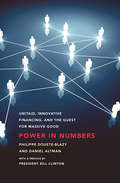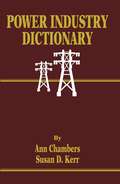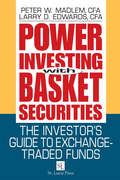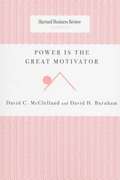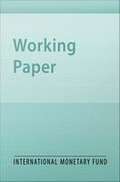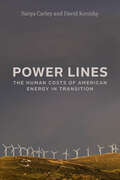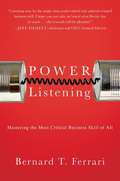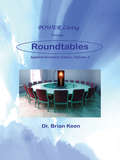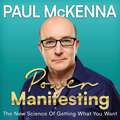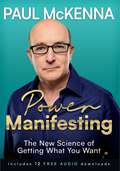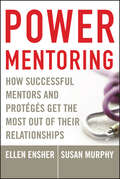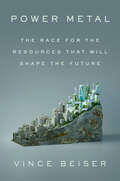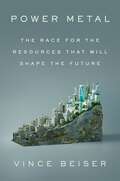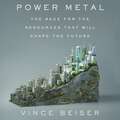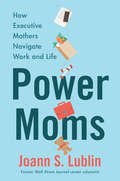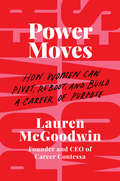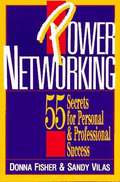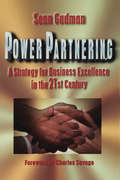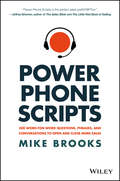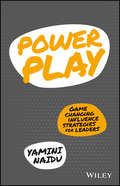- Table View
- List View
Power Hungry: The Myths of "Green" Energy and the Real Fuels of the Future
by Robert BryceThe promise of green jobs and a clean energy future has roused the masses. But as Robert Bryce makes clear in this provocative book, that vision needs a major re-vision. We cannot--and will not--quit using carbon-based fuels at any time in the near future for a simple reason: they provide the horsepower that we crave. The hard reality is that oil, coal, and natural gas are here to stay. Fueling our society requires that we make good decisions and smart investments based on facts. In "Power Hungry," Bryce crushes a phalanx of energy myths, showing why renewables are not green, carbon capture and sequestration won't work, and even--surprise --that the U. S. is leading the world in energy efficiency. "Power Hungry" delivers a clear-eyed view of what's needed to transform the gargantuan global energy sector.
Power In Numbers: UNITAID, Innovative Financing, and the Quest for Massive Good
by Bill Clinton Philippe Douste-Blazy Daniel AltmanThe story of UNITAID begins with two world leaders but quickly becomes a lesson in popular philanthropy, involving millions of people each making a small contribution to a program aimed at treating and ultimately eliminating the threat of HIV/AIDS, tuberculosis and malaria in the developing world. In partnership with the Clinton HIV/AIDS Initiative (CHAI), UNICEF, and other organizations, UNITAID has pioneered techniques for raising massive amounts of money from a wide pool of donors. UNITAIDOCOs newest program, collecting small contributions via a check-box on the worldOCOs biggest travel websites, launches in the United States in January 2010. It is a fascinating model for philanthropy, proving that you can scale up both the fundraising and the ambition of lifesaving treatment programs. Moreover, UNITAID has proved able to continue its work uninterrupted by the financial turmoil that has blighted other private and government aid programs. It provides a model for challenging times. Launched as a crucial component of UNITAIDOCOs OC MassiveGoodOCO substantial national publicity and promotion campaign, "Power in Numbers" is an inspiring case study for anyone interested in social justice, public health, philanthropy, or fundraising.
Power Industry Dictionary
by Ann Chambers Susan KerrThis quick reference offers a broad spectrum of nearly 4,000 industry terms and phrases. Terms used in generation, transmission, and distribution can be found here, along with common business and billing language and terms related to the major governmental and industry regulations. Environmental terms and phrases relevant to the electric power industry are also included. As a convenience, additional reference material is located in the back of this volume, including an assortment of conversion tables, a table of the chemical elements and their associated symbols and weights, and a contact list of prominent industry organizations.
Power Investing With Basket Securities: The Investor's Guide to Exchange-Traded Funds
by Peter W. Madlem Larry D. EdwardsTremendously versatile, basket securities have the potential to change the way money is managed. This book provides the proper definition of the basket security, a brief exploration of their true history, and powerful ways to exploit their advantages. The authors explore simple yet effective ways basket securities can be used in asset management strategies including trading the market, building a diversified core, or creating a thousand stock portfolio. They cover the broad array of currently available basket securities and discuss others that are on the horizon, what and when to buy and sell, and how to protect investments from market declines.
Power Laws in Firm Size and Openness to Trade: Measurement and Implications
by Andrei A. Levchenko Julian Di Giovanni Romain RancièreA report from the International Monetary Fund.
Power Lines: The Human Costs of American Energy in Transition
by Sanya Carley David KoniskyOn American energy and its persisting power to destroy. In the United States, the promise of a green-energy future is complicated by its realities. The country’s legacy energy systems are decrepit; the rollout of new technologies is unequal and piecemeal; households find themselves increasingly without reliable or affordable access; and Americans are excluded from the decisions that shape their energy futures. Having power in America has become an exercise in race, class, and wealth—in more ways than one. Power Lines is a sweeping portrait of American energy in the twenty-first century, rendered in terms of its increasing—and inevitable—human costs. Coal miners in West Virginia lose their livelihoods as energy markets change; historically marginalized households cannot easily access new technologies; children in “sacrifice zones” adjacent to mineral-mining sites suffer health problems and limited resources; and cities and towns are burdened from the production of alternative energies. Sanya Carley and David Konisky show current challenges and an uncertain future of America’s greatest policy imperative. The result is not only sobering but also essential for planning and pursuing a clean-energy transition that improves on the errors of the past.
Power Listening: Mastering the Most Critical Business Skill of All
by Bernard T. FerrariListening is harder than it looks- but it's the difference between business success and failure. Nothing causes bad decisions in organizations as often as poor listening. But Bernard Ferrari, adviser to some of the nation's most influential executives, believes that such missteps can be avoided and that the skills and habits of good listening can be developed and mastered. He offers a step-by-step process that will help readers become active listeners, able to shape and focus any conversation. Ferrari reveals how to turn a tin ear into a platinum ear. His practical insights include: Good listening is hard work, not a passive activity Good listening means asking questions, challenging all assumptions, and understanding the context of every interaction Good listening results in a new clarity of focus, greater efficiency, and an increased likelihood of making better decisions Good listening can be the difference between a long career and a short one .
Power Living Through Roundtables: Applied Business Ethics
by Brian KeenPower LivingThroughRountables is the third book in the Applied Business Ethics series. Roundtables have beem viewed most often as relating to King Arthur and the Knights of the Roundtable. You will discover the actual meaning of Roundtable, and why it is far more than a round table. You will learn how a Roundtable is the best methodology for networking. Networking skills will enhance your potential for building your business. Specific networking tools are presented in the books to assist you in growing your business. Utilizing the scientifically-verifiable data you can start through knowing whether your business is really a micro-, small-, medium-, or large-business. Many owners especially small business owners, think that they have small-business when they reakky are a micro-business. For people interested in a new profession observe the benefits of the CGE professional designation. CGEs can assist your business to grow.
Power Manifesting: The New Science of Getting What You Want
by Paul McKennaWould you like to have the life of your dreams?Great healthAmazing relationshipsA fantastic careerSignificant wealthReal happinessThen this book is for you!Millions of people are familiar with manifesting what they want, creating results through goal setting, focus of attention and actions. Paul McKenna has spent the last four decades studying super-achievers, uncovering some extraordinary discoveries to create a revolutionary formula for getting what you want in life, through an advanced set of easy-to-do processes called 'Power Manifesting'. Using scientifically proven techniques, he has created a specific set of strategies that programme your neuro-coding to place powerful, positive suggestions in your unconscious mind that direct all your behaviours, thoughts, feelings and energy into achieving whatever it is you want!If you are not getting what you want in life, or even if your life is already amazing, by using the new science of Power Manifesting, it will take it to even greater heights of success, happiness and joy, in every area of your life! In the few hours that it takes you to read this book and do the techniques, you will start to notice massive changes in levels of motivation and positivity.Through a mix of quantum physics and Neuro-Linguistic Programming, you will be able to easily programme your mind for success and your life will become even more amazing than you'd ever dreamed possible before!
Power Manifesting: The New Science of Getting What You Want
by Paul McKennaWould you like to have the life of your dreams?Great healthAmazing relationshipsA fantastic careerSignificant wealthReal happinessThen this book is for you!Millions of people are familiar with manifesting what they want, creating results through goal setting, focus of attention and actions. Paul McKenna has spent the last four decades studying super-achievers, uncovering some extraordinary discoveries to create a revolutionary formula for getting what you want in life, through an advanced set of easy-to-do processes called 'Power Manifesting'. Using scientifically proven techniques, he has created a specific set of strategies that programme your neuro-coding to place powerful, positive suggestions in your unconscious mind that direct all your behaviours, thoughts, feelings and energy into achieving whatever it is you want!If you are not getting what you want in life, or even if your life is already amazing, by using the new science of Power Manifesting, it will take it to even greater heights of success, happiness and joy, in every area of your life! In the few hours that it takes you to read this book and do the techniques, you will start to notice massive changes in levels of motivation and positivity.Through a mix of quantum physics and Neuro-Linguistic Programming, you will be able to easily programme your mind for success and your life will become even more amazing than you'd ever dreamed possible before!
Power Manifesting: The New Science of Getting What You Want
by Paul McKennaWould you like to have the life of your dreams?Great healthAmazing relationshipsA fantastic careerSignificant wealthReal happinessThen this book is for you!Millions of people are familiar with manifesting what they want, creating results through goal setting, focus of attention and actions. Paul McKenna has spent the last four decades studying super-achievers, uncovering some extraordinary discoveries to create a revolutionary formula for getting what you want in life, through an advanced set of easy-to-do processes called 'Power Manifesting'. Using scientifically proven techniques, he has created a specific set of strategies that programme your neuro-coding to place powerful, positive suggestions in your unconscious mind that direct all your behaviours, thoughts, feelings and energy into achieving whatever it is you want!If you are not getting what you want in life, or even if your life is already amazing, by using the new science of Power Manifesting, it will take it to even greater heights of success, happiness and joy, in every area of your life! In the few hours that it takes you to read this book and do the techniques, you will start to notice massive changes in levels of motivation and positivity.Through a mix of quantum physics and Neuro-Linguistic Programming, you will be able to easily programme your mind for success and your life will become even more amazing than you'd ever dreamed possible before!
Power Mentoring: How Successful Mentors and Protégés Get the Most Out of Their Relationships
by Ellen A. Ensher Susan MurphyWritten to reflect the realities of todays business environment, Power Mentoring is a nuts-and-bolts guide for anyone who wants to create a connection with a protg or mentor, or to improve a current mentoring relationship. Filled with illustrative examples and candid insights from fifty of America'smost successful mentors and protgs, Power Mentoring unlocks the secrets of great mentoring relationships and shows how anyone (including those who are well established in their careers, or those who are just starting out) can become a successful mentor or protg. Based on compelling interviews from Ellen Ensher and Susan Murphys own research, this important resource explains what it takes to develop a power mentoring network consisting of a variety of mentors across a range of organizations and industries. The authors provide strategies for establishing suchpower mentoring relationships, outline the best practices, and offer insights from mentors and protgs in a variety of fields including technology, politics, and the media.
Power Metal: The Race for the Resources That Will Shape the Future
by Vince BeiserThe powerful ways the metals we need to fuel technology and energy are spawning environmental havoc, political upheaval, and rising violence — and how we can do better.An Australian millionaire&’s plan to mine the ocean floor. Nigerian garbage pickers risking their lives to salvage e-waste. A Bill Gates-backed entrepreneur harnessing AI to find metals in the Arctic. These people and millions more are part of the intensifying competition to find and extract the minerals essential for two crucial technologies: the internet and renewable energy. In Power Metal, Vince Beiser explores the Achilles&’ heel of &“green power&” and digital technology – that manufacturing computers, cell phones, electric cars, and other technologies demand skyrocketing amounts of lithium, copper, cobalt, and other materials. Around the world, businesses and governments are scrambling for new places and new ways to get those metals, at enormous cost to people and the planet. Beiser crisscrossed the world to talk to the people involved and report on the damage this race is inflicting, the ways it could get worse, and how we can minimize the damage. Power Metal is a compelling glimpse into this disturbing yet potentially promising new world.
Power Metal: The Race for the Resources That Will Shape the Future
by Vince BeiserThe powerful ways the metals we need to fuel technology and energy are spawning environmental havoc, political upheaval, and rising violence - and how we can do better.An Australian millionaire's plan to mine the ocean floor. Nigerian garbage pickers risking their lives to salvage e-waste. A Bill Gates-backed entrepreneur harnessing AI to find metals in the Arctic.These people and millions more are part of the intensifying competition to find and extract the minerals essential for two crucial technologies: the internet and renewable energy. In Power Metal, Vince Beiser explores the Achilles' heel of "green power" and digital technology - that manufacturing computers, cell phones, electric cars, and other technologies demand skyrocketing amounts of lithium, copper, cobalt, and other materials. Around the world, businesses and governments are scrambling for new places and new ways to get those metals, at enormous cost to people and the planet.Beiser crisscrossed the world to talk to the people involved and report on the damage this race is inflicting, the ways it could get worse, and how we can minimize the damage. Power Metal is a compelling glimpse into this disturbing yet potentially promising new world.
Power Metal: The Race for the Resources That Will Shape the Future
by Vince BeiserThe powerful ways the metals we need to fuel technology and energy are spawning environmental havoc, political upheaval, and rising violence - and how we can do better.An Australian millionaire's plan to mine the ocean floor. Nigerian garbage pickers risking their lives to salvage e-waste. A Bill Gates-backed entrepreneur harnessing AI to find metals in the Arctic.These people and millions more are part of the intensifying competition to find and extract the minerals essential for two crucial technologies: the internet and renewable energy. In Power Metal, Vince Beiser explores the Achilles' heel of "green power" and digital technology - that manufacturing computers, cell phones, electric cars, and other technologies demand skyrocketing amounts of lithium, copper, cobalt, and other materials. Around the world, businesses and governments are scrambling for new places and new ways to get those metals, at enormous cost to people and the planet.Beiser crisscrossed the world to talk to the people involved and report on the damage this race is inflicting, the ways it could get worse, and how we can minimize the damage. Power Metal is a compelling glimpse into this disturbing yet potentially promising new world.
Power Moms: How Executive Mothers Navigate Work and Life
by Joann S. LublinA retired Wall Street Journal editor and mother compares two generations of women—boomers and GenXers—to examine how each navigates the emotional and professional challenges involved in juggling managerial careers and families.For the first time in American history, a significant number of mothers are heading major corporations, including General Motors, Ulta Beauty, and Best Buy. Over the past several decades, women have made gains throughout executive suites. Yet these “Power Moms” still struggle with balancing their management responsibilities with raising children. Joann S. Lublin draws on the experiences of the nation’s two generations of these successful women to measure how far we’ve come—and how far we still need to go.Lublin combines her own insights with those of eighty-five executive mothers across industries—including experienced public-company chiefs such as Carol Bartz, the first woman to command Autodesk and Yahoo; Hershey’s Michele Buck, DuPont’s Ellen Kullman, ITT’s Denise Ramos, and WW International’s Mindy Grossman—and twenty-five of their grown daughters. Lublin reveals how trailblazer boomers, many now in their sixties, often endured sweeping disapproval for their demanding management careers, even as their own daughters sometimes rejected their choices. While the second wave of executive mothers—all under forty-five—handle working parenthood with less angst, they still lead stressful lives. Power Moms provides lessons and advice to help today’s professional women, their families, and their employers navigate this challenging terrain. Lublin looks at the trade-offs mothers are too often forced to make between work and family and the root causes, including the dearth of large-scale paid parental leave and other family-friendly policies. While it celebrates the gains women have made, Power Moms makes clear how much more must be done to make being a working mother easier.
Power Moves: How Women Can Pivot, Reboot, and Build a Career of Purpose
by Lauren McGoodwinFrom the founder of the influential website Career Contessa, an invaluable career resource for women feeling stuck or unfulfilled that combines actionable advice, learning tools to make impactful life changes, and an in-depth discussion of how to build a meaningful career on your terms.With her popular website Career Contessa, Lauren McGoodwin built an audience of ambitious, professional, millennial women who thought they did everything right—they got the degree, the internship, and even the promotion—but still wondered why they felt stuck and unfulfilled. The first site of its kind to focus on the unique, complex aspects of women's careers, Career Contessa offers women the smart advice they deserve, in a voice that resonates.Drawing on the insights and lessons developed from Career Contessa, Power Moves is the essential handbook that helps professional women truly feel understood so they can bypass perfection and planning and head straight to evolving. McGoodwin addresses young professionals’ number-one concern: career transitions and growth, and engages them with specific goals, including:What is a Power Move and why they matterCutting out comparison, shame, and self-loathingHow to abandon the elusive “dream job”Embracing your inner questioner, your inner quester, and your inner-quitterMaking money moves and taking control of your financial futureTuning out from the noise and tuning into your voicePower Moves is filled with the information, guidance, advice, and essential tools, (including helpful graphics) that can help women take decisive, bold steps without self-doubt and fear, Power Moves shows women how to build a successful career on their own terms.
Power Networking: 55 Secrets for Personal & Professional Success
by Donna Fisher Sandy VilasWhat's your networking IQ? Are you a "Power Networker"? Are you a Lone Ranger? Take the self-Assessment and find out!! This practical, inspiring book will teach you the secrets of creating a powerful personal and professional network. Packed with 55 proven methods for networking success, it shows you how to: Put into practice the life-affirming Power Networking philosophy Eliminate the roadblocks to successful networking Use the "stepping-stone" method to meet anyone you want Say good-bye to the Lone Ranger mentality Make requests that get the results you want Introduce yourself so people will be inspired to call on you Generate a continuous flow of referrals from clients and associates Uncover and activate your "hidden network"
Power Partnering
by Sean GadmanPower Partnering is a brilliant yet refreshingly simple approach that breaks innovative thinking and acting down into four distinct contexts, allowing people to respond to complex situations in highly creative and innovative ways. In the not too distant future, successful companies will be defined by their ability to manage their knowledge assets. Power partnering is one very important strategy for success. It avoids the pitfalls inherent in traditional approaches to running businesses, particularly those that emphasize 'power over and control of' people. This book is concerned with creating environments of interaction where co-workers, customers, suppliers and customers' customers interact in meaningful and creative ways. These environments promote new ways of thinking, insightful perspectives and fresh ideas.
Power Phone Scripts: 500 Word-for-Word Questions, Phrases, and Conversations to Open and Close More Sales
by Mike BrooksStart closing sales like top producers! Have you ever found yourself at a loss for what to say when the gatekeeper asks you what your call is about? Have your palms ever sweated when the decision maker shuts you down with: “I wouldn’t be interested”? Has your heart taken a fast dive into your stomach when, at the start of your presentation, your prospect tells you that they’ve thought about it and are just going to pass? If you’re in sales, then the question isn’t “Have you ever felt this way?”, but rather, “How often do you feel this way? Are you finally ready to learn how to confidently and effectively overcome these objections, stalls, and blow-offs? If so, Power Phone Scripts was written for you! Unlike other books on sales that tell you what you should do (like build value – hard to do when the prospect is hanging up on you!), Power Phone Scripts provides word-for-word scripts, phrases, questions, and comebacks that you can use on your very next call. Learn to overcome resistance, get through to the decision maker, and then, once you have him or her on the phone, make an instant connection and earn the right to have a meaningful conversation. You’ll be equipped with proven questions, conversation starters, and techniques to learn whether or not they are even right for your product or service, and, if they aren’t, who else in their company or another department might be. Power Phone Scripts is the sales manual you’ve been looking for: over 500 proven, current, and non-salesy phrases, rebuttals, questions, and conversation openers that will instantly make you sound more confident – just like the top producing sales pros do right now. Gone will be your call reluctance; gone will be your fear of calling prospects back for presentations and demos; gone will be the fear of asking for the sale at the end of your pitch! This practical guide is filled with effective scripts for prospecting, emailing, voice mails, closes, and tons of rebuttals to recurring objections you get like: “It costs too much” “We already have a vendor for that” “I’m going to need to think about it” “I need to talk to the boss or committee” and so many others… More than just phone scripts, this book provides practical, comprehensive guidance that every inside sales rep needs. Conquer concerns, provide answers, motivate action, and be the conduit between your prospect’s problems and your solution. Actionable, fun, and designed to work within the current sales environment, this invaluable guide is your ticket to the top of the leader board. With Power Phone Scripts, you will never be at a loss of what to say to a prospect or client. Communication is everything in sales, and being on top of your game is no longer enough when top producers are playing a different game altogether. You cannot achieve winning stats if you're not even on the field. If you're ready to join the big league, Power Phone Scripts is the playbook you need to win at inside sales.
Power Play
by Yamini NaiduDiscover the secrets of influence, impact and transformational leadership Power Play is the powerful and practical 21st century guide to mega-impact and influence, providing business leaders with explosive influence strategies to move people into action and results. Influence, like gravity, pulls success into your orbit and gives you the power to make real changes in your relationships, your organisation and the world. This book explores the different types of power and you will learn when to coerce, when to collaborate and when to connect. You'll delve into areas of influence that you may not have considered, including the power of message, context, empathy, humour, positioning, love and more. This book identifies the strengths and weaknesses of each of these influence tools and offers practical tips so you can create a seismic shift in your influence while maintaining authenticity and integrity. Influence is the key factor that allows you to build powerful relationships that facilitate more effective leadership. It can mean the difference between achieving results and falling short, keeping clients or losing them, winning that pitch or blowing it. This book shows you how to amplify your influence and turbo charge your impact in every area. Understand the different types of power Discover new tools of influence and the art of power play Explore influence strategies with impact and integrity Become a power player and deliver results Influence is a science, and it's the key to your personal and professional success. Power Play helps you build a bottomless supply, and wield it with authenticity, compassion and integrity.
Power Play (A): Nintendo in 8-bit Video Games
by Adam Brandenburger Julia Kou Monique BurnettThe home video-game industry began in 1972 with the founding of Atari. After riding a dramatic boom and bust in the early 1980s, most players left the business. Nintendo of Japan then rebuilt the industry--establishing a commanding worldwide position by the end of the decade. By 1990, Nintendo game systems could be found in one out of every three households--in both Japan and the United States. The company's stock market value exceeded that of Sony or Nissan. The case describes the steps Nintendo took to achieve this success. Also covers the U.S. antitrust investigation of Nintendo.
Power Play (B): Sega in 16-bit Video Games
by Adam BrandenburgerHome video-game systems were pioneered by the U.S. company Atari in the mid-1970s. After going through boom and bust in the early 1980s, the industry was resurrected in the mid-1980s by the Japanese company Nintendo. With its 8-bit video-game system, Nintendo established a dominant position in a greatly expanded home video-game market. The case focuses on the post-1987 period, when new 16-bit home video-game technology began to come on the market. First to introduce a next-generation system was the major Japanese electronics company NEC. Second out with a 16-bit system was Sega, the leader in the Japanese arcade-game business and an unsuccessful player in the 8-bit home video-game market. Nintendo itself moved more slowly in introducing a 16-bit system. The case ends with the battle between Sega and Nintendo to gain the edge in 16-bit sales.
Power Play (B): Sega in 16-bit Video Games
by Adam BrandenburgerHome video-game systems were pioneered by the U.S. company Atari in the mid-1970s. After going through boom and bust in the early 1980s, the industry was resurrected in the mid-1980s by the Japanese company Nintendo. With its 8-bit video-game system, Nintendo established a dominant position in a greatly expanded home video-game market. The case focuses on the post-1987 period, when new 16-bit home video-game technology began to come on the market. First to introduce a next-generation system was the major Japanese electronics company NEC. Second out with a 16-bit system was Sega, the leader in the Japanese arcade-game business and an unsuccessful player in the 8-bit home video-game market. Nintendo itself moved more slowly in introducing a 16-bit system. The case ends with the battle between Sega and Nintendo to gain the edge in 16-bit sales.

